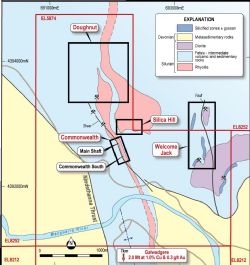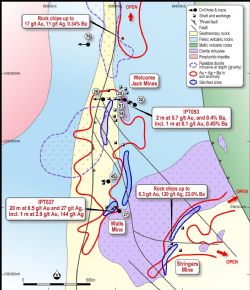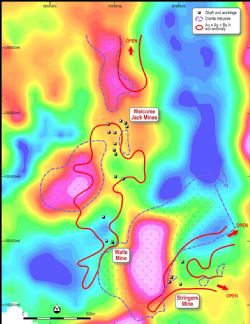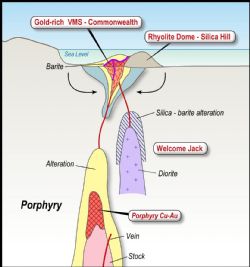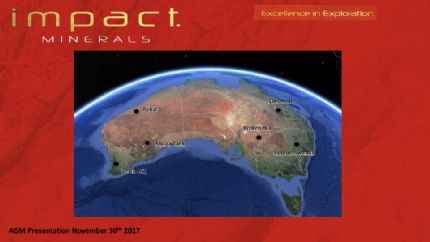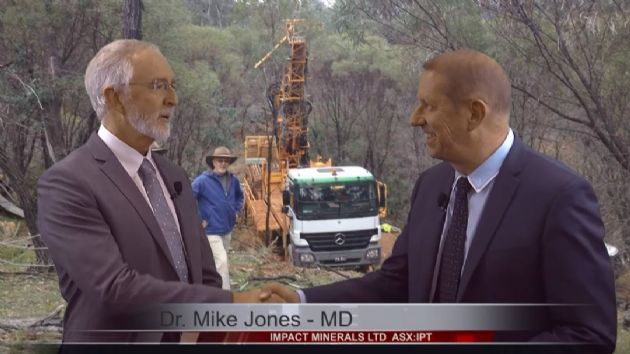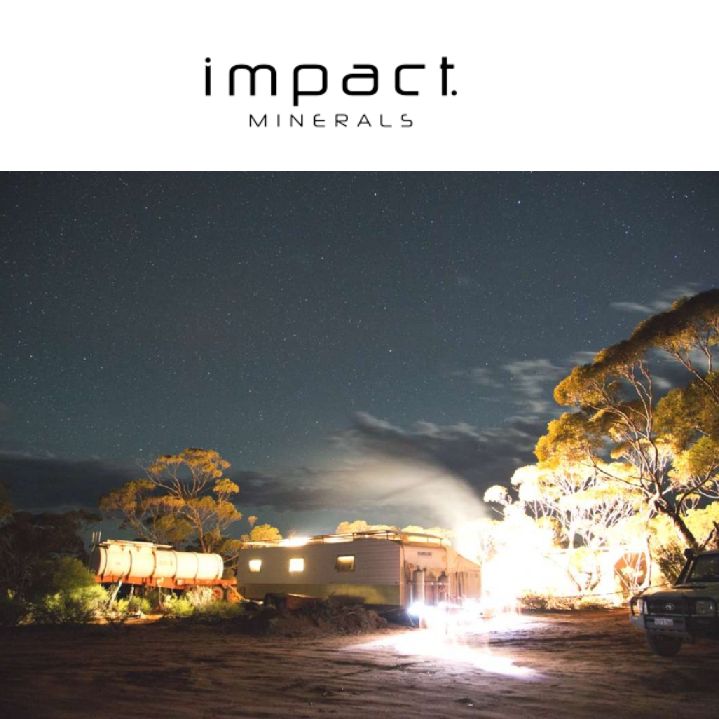 New Drill Targets along Welcome Jack Trend at Commonwealth
New Drill Targets along Welcome Jack Trend at Commonwealth
Perth, April 13, 2018 AEST (ABN Newswire) - New drill and rock chip assays together with an interpretation of ground gravity data have identified new drill targets along the Welcome Jack Trend, located 1.5 kilometres east of the Commonwealth-Silica Hill area at Impact Minerals Limited's ( ASX:IPT) 100%-owned Commonwealth Project, 100 km north of Orange in New South Wales (see Figure 1 in link below).
ASX:IPT) 100%-owned Commonwealth Project, 100 km north of Orange in New South Wales (see Figure 1 in link below).
These drill targets will be tested as part of an upcoming drill programme that will also follow up exceptional gold and silver results recently returned from the Silica Hill Prospect (see announcement dated 13th February 2018). The drill programme should commence by late June subject to approvals.
New Results
The new assay results demonstrate high grade gold and silver is associated with barite (barium sulphate) and linear zones of silicification over a strike length of at least 2,000 metres along the Welcome Jack Trend. In the south these zones occur around the margins of a diorite intrusion exposed at surface (see Figure 2 in link below).
Impact has previously shown that barite is an important pathfinder element for the exploration model proposed for the Commonwealth project but is costly to assay for and not done routinely (see Discussion below and announcement dated 31st May 2017).
Key results include (see Figure 2 in link below):
- In Impact's 2017 drill programme, drill hole CMIPT053 was drilled under old gold workings at the Welcome Jack Prospect and returned:
o 2 metres at 5.7 g/t gold and 0.4% barium from 28 metres down hole including
1 metre at 8 g/t gold and 0.45% barium from 29 metres.
- A rock chip sample taken 700 metres north of CMIPT053 returned:
17.0 g/t gold, 11 g/t silver and 0.34% barium. This area has not been drilled.
- At the Walls Prospect 800 m to the south of Welcome Jack a 20 metre thick silver-gold zone was discovered in CMIPT027 (see announcement dated 30th June 2016). New re-assays of two anomalous samples for barium within this zone returned:
o 1 m at 2.9 g/t gold, 144 g/t silver and 0.2% barium and
o 1 m at 1.0 g/t gold, 46 g/t silver and 0.8% barium within the thicker zone of
20 m at 0.5 g/t gold and 27 g/t silver from 55 metres.
- At the Stringers Prospect located 500 metres south of the Walls Prospect, rock chips returned up to 6.3 g/t gold and 120 g/t silver associated with massive barite with assays of up to 23.0% barium.
All of these results are associated with large and extensive gold-silver-barium-in-soil anomalies, which at Walls and Stringers occur around the margins of the diorite intrusion (see Figure 2 in link below).
Images of previously collected ground gravity data show that the diorite, and particularly the western half, is characterised by a gravity high (see Figures 2 and 3 in link below). An outcrop of similar diorite is also associated with the edge of a gravity high at Welcome Jack and is also adjacent to one of the gold-silver-barium-in-soil anomalies (see Figures 2 and 3 in link below).
This association suggests gravity highs along the Welcome Jack Trend may represent buried but relatively near surface diorites.
Two other gravity highs with strong gold-silver-barium-in soil anomalies along their margins are also readily identifiable in the data (see Figure 3 in link below). The gravity highs are interpreted as potential buried intrusions and accordingly these areas are attractive drill targets for high grade gold, silver and barite preserved at depth. Impact proposes to drill these priority targets in the upcoming drill season
Discussion
Impact has previously shown that barite is an important pathfinder element for the exploration model proposed for the Commonwealth project; that is, gold-rich volcanogenic massive sulphide mineralisation similar to the Eskay Creek deposit in British Columbia (>3 million ounces of gold and 180 million ounces of silver;) and potentially underlain by a porphyry copper-gold system (see Figure 4 in link below and see announcement dated 31st May 2017) .
For example barite is intimately associated with the massive sulphide deposit at Main Shaft (see Figure 1 in link below) where a key drill result was returned from CMIPT031 of:
7 metres at 6.3 g/t gold, 496 g/t silver (15.9 ounces), 7.2% zinc, 2.9% lead and 9.0% barium from 91 metres including 3 metres at 10.6 g/t gold, 571 g/t silver (18.4 ounces) 7.8% zinc, 2.1% lead and 14.9% barium.
Unfortunately high levels of barium (>3,000 ppm) can only be assayed accurately at high levels by a costly X-Ray Fusion analysis. Accordingly barium assays are not done routinely on drill core and only selected samples, including those reported above, were chosen to ascertain the likely distribution of barium along the Welcome Jack Trend.
The fact that every sample assayed along the Trend returned high levels of barium is considered to be very encouraging for further exploration.
In addition it is possible that the diorites are part of an intrusive complex interpreted to underlie and be driving the entire mineralised system at Commonwealth-Silica Hill-Welcome Jack. This is a key feature of the model proposed by Impact for the area which suggests that such an intrusive complex may contain a porphyry copper-gold deposit at depth similar to Cadia-Ridgeway and North Parkes (see announcement 31 July 2017 and Figure 4 in link below).
Next Steps
All of Impact's work indicates that the mineralised system in the entire Commonwealth-Silica Hill-Welcome Jack Trend is part of one very large system covereing at least 5 sq km in area. In all likelihood the mineralisation at the different locations is connected and may represent different parts of an obliquely exposed, vertically zoned system (see Figure 4 in link below).
Large areas of this system remain untested by drilling and it is evident that there is signficant exploration upside in the area.
The nature of the mineralisation at Silica Hill with the extensive visible silver minerals proustite and pyrargyrite is unique in Australia. Therefore a detailed review and synthesis of all the drill hole data including assays, hand held XRF data and geological and structural data has been completed and the next round of drill targets has been identified.
The next drill programme will commence as soon as practicable and hopefully before the end of June. Statutory approvals for new drill pads have been lodged and negotiations have progressed to extend the Land Access Agreement with the main land holder at Commonwealth-Silica Hill.
To view figures, please visit:
http://abnnewswire.net/lnk/90C0ABC6
About Impact Minerals Limited
 Impact Minerals Limited (ASX:IPT) is an exploration company listed on the ASX in November 2006. The Company manages extensive tenement holdings (>2,000 km2) within Australia featuring significant potential for high-grade mineral deposits of gold, silver, lead, zinc, copper, nickel and PGM's. The Directors of the Company have extensive experience in mineral exploration and a strong history of exploration success, business development and corporate management. Impact Minerals intends to build wealth for its shareholders through a vigorous campaign of project generation and evaluation with a view towards profitable mining operations.
Impact Minerals Limited (ASX:IPT) is an exploration company listed on the ASX in November 2006. The Company manages extensive tenement holdings (>2,000 km2) within Australia featuring significant potential for high-grade mineral deposits of gold, silver, lead, zinc, copper, nickel and PGM's. The Directors of the Company have extensive experience in mineral exploration and a strong history of exploration success, business development and corporate management. Impact Minerals intends to build wealth for its shareholders through a vigorous campaign of project generation and evaluation with a view towards profitable mining operations.
![abnnewswire.com]()
Related Companies
Social Media
Share this Article

 ASX:IPT) 100%-owned Commonwealth Project, 100 km north of Orange in New South Wales (see Figure 1 in link below).
ASX:IPT) 100%-owned Commonwealth Project, 100 km north of Orange in New South Wales (see Figure 1 in link below).  Impact Minerals Limited (ASX:IPT) is an exploration company listed on the ASX in November 2006. The Company manages extensive tenement holdings (>2,000 km2) within Australia featuring significant potential for high-grade mineral deposits of gold, silver, lead, zinc, copper, nickel and PGM's. The Directors of the Company have extensive experience in mineral exploration and a strong history of exploration success, business development and corporate management. Impact Minerals intends to build wealth for its shareholders through a vigorous campaign of project generation and evaluation with a view towards profitable mining operations.
Impact Minerals Limited (ASX:IPT) is an exploration company listed on the ASX in November 2006. The Company manages extensive tenement holdings (>2,000 km2) within Australia featuring significant potential for high-grade mineral deposits of gold, silver, lead, zinc, copper, nickel and PGM's. The Directors of the Company have extensive experience in mineral exploration and a strong history of exploration success, business development and corporate management. Impact Minerals intends to build wealth for its shareholders through a vigorous campaign of project generation and evaluation with a view towards profitable mining operations.


